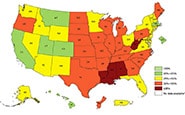
FROM THE Centers For Disease Control and Prevention...
Adult Obesity Facts
Obesity Prevalence Maps
Adult obesity prevalence by state and territory using self-reported information from the Behavioral Risk Factor Surveillance System.
Obesity is a common, serious, and costly disease
From 1999 –2000 through 2017 –2018, US obesity prevalence increased from 30.5% to 42.4%. During the same time, the prevalence of severe obesity increased from 4.7% to 9.2%.
Obesity-related conditionsexternal icon include heart disease, stroke, type 2 diabetes and certain types of cancer. These are among the leading causes of preventable, premature death.
The estimated annual medical cost of obesityexternal icon in the United States was $147 billion in 2008. Medical costs for people who had obesity was $1,429 higher than medical costs for people with healthy weight.
Obesity affects some groups more than others
[Read CDC National Center for Health Statistics (NCHS) data brief]
[Read CDC National Center for Health Statistics (NCHS) data brief]
Non-Hispanic Black adults (49.6%) had the highest age-adjusted prevalence of obesity, followed by Hispanic adults (44.8%), non-Hispanic White adults (42.2%) and non-Hispanic Asian adults (17.4%).
The obesity prevalence was 40.0% among adults aged 20 to 39 years, 44.8% among adults aged 40 to 59 years, and 42.8% among adults aged 60 and older.
Obesity and socioeconomic status
[Read the Morbidity and Mortality Weekly Report (MMWR)]
The association between obesity and income or educational level is complex and differs by sex and race/ethnicity.
[Read the Morbidity and Mortality Weekly Report (MMWR)]
The association between obesity and income or educational level is complex and differs by sex and race/ethnicity.
Overall, men and women with college degrees had lower obesity prevalence compared with those with less education.
The same obesity and education pattern occurred among non-Hispanic White, non-Hispanic Black, and Hispanic women, and non-Hispanic White men. However, the differences were not all statistically significant. Although the difference was not statistically significant among non-Hispanic Black men, obesity prevalence increased with educational attainment.
No differences in obesity prevalence by education level were noted among non-Hispanic Asian women and men and Hispanic men.
Among men, obesity prevalence was lower in the lowest and highest income groups compared with the middle-income group. Researchers observed this pattern among non-Hispanic White and Hispanic men. Obesity prevalence was higher in the highest income group than in the lowest income group among non-Hispanic Black men.
Among women, obesity prevalence was lower in the highest income group than in the middle and lowest income groups. Researchers observed this pattern among non-Hispanic White, non-Hispanic Asian, and Hispanic women. Among non-Hispanic Black women, there was no difference in obesity prevalence by income.